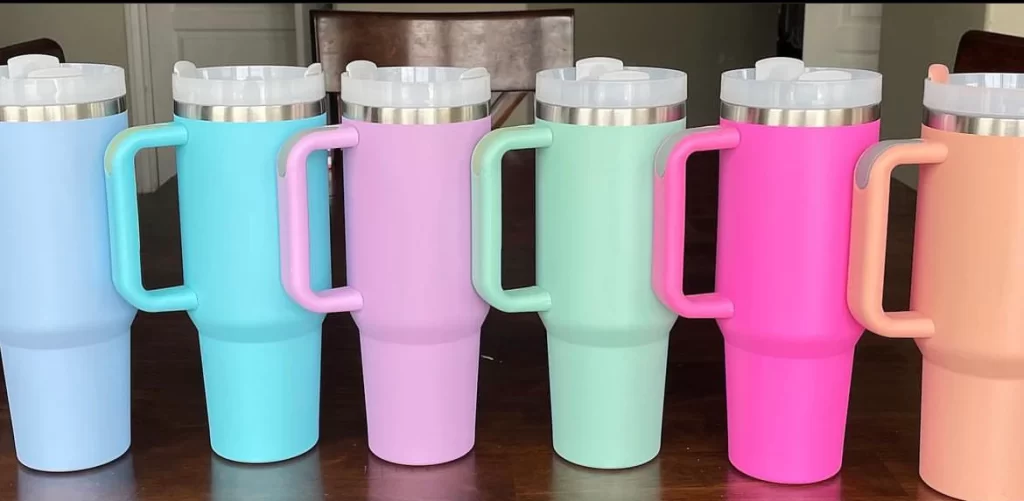
Stanley tumblers have surged in popularity in recent times, becoming a favored choice for keeping drinks hot or cold for extended periods. They’ve become a beacon of durability and effectiveness in the drinkware market and have gathered a robust following among outdoor enthusiasts and everyday users alike.
However, a new thread of concern has woven its way through the fabric of this popularity. A wave of worry has been initiated by some vigilant TikTok users who have demonstrated, using lead test kits, that Stanley tumblers contain a trace amount of lead. The video clips showing the positive tests for lead on certain parts of the tumblers have sparked an imperative conversation about product safety and consumer awareness.
In understanding the situation, it’s critical to highlight that the areas containing lead are not in direct contact with the contents of the tumbler nor the consumer. Stanley has emphasized this point on their website, reassuring customers that the external lead presence does not compromise the safety of the product’s use according to U.S. regulatory standards. Nevertheless, the brand has faced pressure to address these concerns transparently and promptly to maintain trust among its customer base.
The apprehension surrounding lead is not without cause. Lead is a toxic metal, and exposure to significant amounts of lead can lead to poisoning. Chronic ingestion or inhalation can result in severe health implications including neurological damage, renal dysfunction, and anemia, among others. Typical sources of lead exposure include peeling paint in older homes, contaminated soil, and some occupational environments, but it’s generally unexpected to find it associated with food or beverage containers.
The mere presence of lead, no matter how minute, in a product intended for daily use such as drinkware can cause understandable dismay. Consumers often choose products with a significant focus on health and safety, opting for items free of BPA and other known hazards. For Stanley, the current issue calls for proactive engagement with its user community, offering not only assurances of safety but clear evidence and the methodology behind their safety claims.
For those who remain concerned about the potential for lead exposure, there are actionable steps one can take. Look out for products that are certified by relevant authorities as lead-free. Additionally, consumers can engage in their own research, reading product descriptions carefully, and reaching out to manufacturers with any questions regarding material composition and safety standards.
In the interim, the allure of Stanley tumblers continues, buoyed by their purported insulating capabilities and stylish designs. However, this latest development is a reminder that vigilance in product safety is an ongoing process, one in which both manufacturers and consumers play integral roles. As we wait for further clarifications and, potentially, new product revisions, the conversation around what we use to consume our daily beverages remains as important as ever.
Do Stanley Tumblers Contain Lead?
In our ongoing efforts to understand the impact of materials used in everyday products, recent scrutiny has fallen upon the iconic Stanley brand, known for its vacuum-sealed containers meant to keep beverages at optimal temperature. The revelation that lead is incorporated into the manufacturing process for achieving vacuum insulation has raised concerns among consumers regarding potential health risks.
A detailed clarification on Stanley’s website explains that the presence of lead is a result of using a standard industry pellet to seal the vacuum insulation at the base of their products. This component of the manufacturing process, they assure, involves placing the lead within an area that subsequently becomes covered with a layer of stainless steel, rendering it inaccessible and unable to pose a threat to the consumer during normal use.
The concern over lead in consumer products is not unique to Stanley. History indicates that other brands have encountered similar issues, with some facing recalls when the lead used in the production of their vacuum-sealed cups became exposed. A notable example was the recall in November 2022, when certain products were found to pose a lead poisoning hazard, as cited by the U.S. Consumer Product Safety Commission.
Experts in environmental health have weighed in on the matter. Dr. Olga Naidenko, an authority in the field of contaminant analysis, underscores the importance of vigilance regarding the presence of lead in consumer goods. As the vice president of science investigations at the Environmental Working Group, her role involves exposing harmful chemicals in products and advocating for safer alternatives.
The debate surrounding lead in vacuum-sealed products has stimulated responses from other industry players. Hydro Flask, a competitor in the market for insulated containers, took to social media platforms to differentiate their manufacturing process. On Instagram, Hydro Flask publicly addressed consumer concerns, proudly announcing that their products are manufactured without the use of lead. Moreover, they highlighted their role as innovators in developing a lead-free sealing process over a decade ago, positioning themselves as leaders in consumer safety within the industry.
As awareness grows and consumers become more conscious of what goes into the production of items they use daily, companies are increasingly held to higher standards of transparency and safety. This development reflects a larger movement towards more robust consumer protection, reducing the use of hazardous materials, and fostering a market that prioritizes health and sustainability over cheaper production costs.
The conversation on the use of lead in vacuum insulation is a powerful reminder of the complexities that lie behind the manufacture of trusted household products. It serves as a call to action for ongoing vigilance and accountability from brands to ensure the safety of their consumers and confidence in their product offerings.
Why Is Lead So Dangerous?
Lead is an element found in nature, but it is hazardous to both humans and animals. Experts unanimously agree that there is no level of lead exposure deemed safe. Particularly susceptible to lead’s detrimental effects are children, who absorb more lead than adults when exposed. Regular exposure to lead, especially in children, can impede intellectual development, impair academic performance, and result in behavioral issues, according to Dr. Diane Calello, Executive and Medical Director of the New Jersey Poison Control Center at Rutgers New Jersey Medical School.
Historically, lead was a common constituent in residential paint, particularly in the 20th century. Consequently, structures erected prior to 1978 are likely to contain remnants of lead-based paint. In prior years, children’s toys frequently included lead, until the Consumer Product Safety Improvement Act of 2008 enforced stricter regulations concerning lead content in consumer goods. Despite these measures, lead presence is still a concern, particularly in vintage, collectible, or foreign-manufactured toys.
Adults are not exempt from lead exposure, which can occur through occupational or environmental sources. Activities such as the smelting process can release lead particles into the atmosphere, posing a risk to those in proximity. Furthermore, the consumption of water from lead pipes, or ingestion of lead-contaminated dust, presents additional exposure pathways.
Consumer products detected to contain hazardous amounts of lead are often subject to recalls. For instance, certain cinnamon applesauce products were recently withdrawn from the market by the Food and Drug Administration (FDA) due to their lead content.
Health complications arising from lead intoxication are severe and may include hypertension, and damage to the brain, kidneys, and the reproductive system. Acute lead exposure may manifest a host of symptoms.
For further information and protection guidelines against lead exposure, consult environmental health agencies or medical professionals.
Short-term exposure to lead could cause:
- Headache
- Abdominal pain
- Colic
- Vomiting
- Anemia
Long-term exposure to lead could cause:
- Irritability
- Lethargy
- Fatigue
- Muscle aches
- Muscle prickling
- Muscle burning
- Constipation
- Difficulty concentrating
- Muscular weakness
- Tremor
- Weight loss
It’s important to see a healthcare provider if you suspect you’ve been exposed to lead.
Does This Mean Stanley Cups are Dangerous to Use?
It is essential to clarify that the presence of lead within the structure of a cup does not inherently pose a direct hazard to health, assuming that the cup remains intact and is utilized according to its intended purpose.
Dr. Diane Calello, an expert in this field, has stated, “Merely being in proximity to lead does not constitute an immediate threat to life and health. When a cup is employed correctly, it should not present a lead-related hazard.”
The manufacturer, Stanley, supports this assertion, reassuring customers through a public announcement that the surface of their cups does not contain lead, thereby ensuring that there is no direct contact between the consumer or any ingested substances and lead.
Furthermore, the company has indicated that should the base cap of any product detach, potentially making exposure to lead possible by unveiling the seal, the item in question would be covered by a Lifetime Warranty and subject to replacement.
Nonetheless, certain specialists advise that young children may be better served by alternative drinking containers.
Dr. Olga Naidenko, a senior advisor for science policy, voiced her concerns: “Given the highly toxic nature of lead, especially to young children, it is prudent to avoid taking risks associated with products designed for their use or which are within their surroundings.”
Therefore, while consuming beverages from an undamaged Stanley tumbler may be considered secure and devoid of risk regarding lead poisoning, individuals looking to purchase a new drinking vessel may want to consider options that do not incorporate lead in their manufacturing processes.
As Dr. Naidenko recommends, “Consumers should seek out water bottle products that are devoid of lead in their design. The potential exposure to a potent neurotoxin such as lead, particularly to young children, due to the usage of a cup or any consumer product, is indefensible. Moreover, statements from several manufacturers who have successfully identified alternative substances to lead for vacuum sealing attest to the avoidability of using this toxic metal.”

